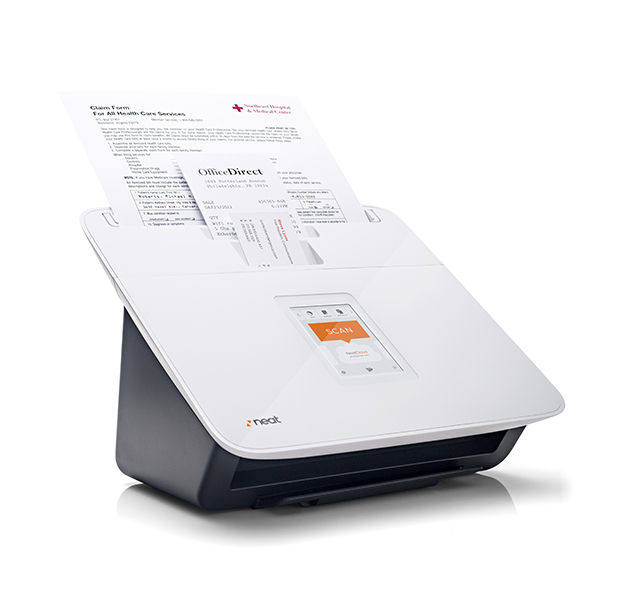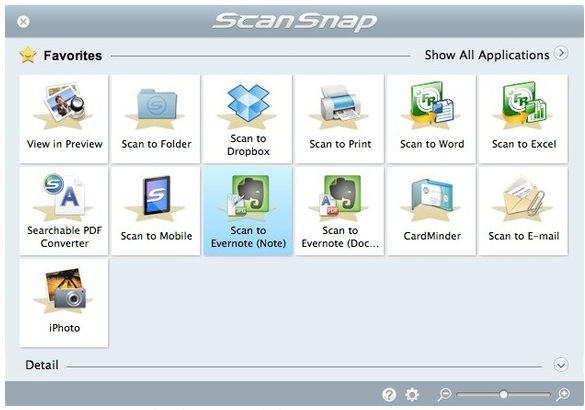NAPO2014: Wirelessly Scanning the Horizon — What’s New in Scanning?
Whether your goal is to go paperless or you just want to make sure you have access to your information no matter where you are, scanning is an obvious solution. We’ve previously covered the basics of scanning as part of a paper-reduction policy, and there’s a whole section on scanning in my 57 Secrets for Organizing Your Small Business.
At the 2014 NAPO Conference and Expo, two long-time stars of the scanning world, Neat and Fujitsu, displayed their newest wares.
FUJITSU
Fujitsu ScanSnap iX500 Desktop Scanner
The ScanSnap iX500 is a desktop scanner (but, as the photo above indicates, not a flatbed scanner) compatible with Macs and PCs as well as mobile devices. (It replaces the Scansnap X1500, a Windows-only scanner.) Suitable for personal or small business use, the big selling point of this model is the ability to scan wirelessly, but the iX500 has myriad interesting features, including:
- scanning to a wide variety of formats, including searchable PDFs, JPEGs, editable Microsoft Word and Excel documents, and others with the press of just one button
- scanning to the cloud, including to Dropbox, Google Drive, Salesforce, and SugarSync, as well as SharePoint, but only for Windows-based PCs. (ScanSnap Folder, also compatible only with Windows-based PCs, allows for wider cloud-centric applications.)
- Wi-Fi connectivity — sure, you can connect your scanner to your computer via a USB cable, but you can also scan directly from the iX500 to your computer via your Wi-Fi connection, cable-free!
- direct scanning to mobile devices — scan a PDF or JPEG from the iX500 to your iOS or Android mobile phone or tablet directly via WiFi
- fast double-sided scanning of color pages at 25 pages/minute at 300 dpi. The iX500 scans both side of a page simultaneously, and images are automatically straightened and cropped, with blank sides removed from the resulting scan. (Although the stated speed is 25 pages/minute, reviews have reported speeds as high as 33 pages/minute. Check out this tweeted Vine of a sheet zooming through the iX500!)
The ScanSnap Quick Menu gives you an idea of the variety of destination options at your disposal:
You can stack up to 50 sheets of paper at a time in the automatic document feeder, and Fujitsu promises that by borrowing “Separation Roller” technology and an “ultrasonic multi-feed sensor” from their professional-grade scanners, they’ve minimized jams and that annoying situation where more than one page gets grabbed at a time (and then never gets scanned at all).
The ScanSnap iX500 comes with productivity software. For both Macs and PCs, there’s Cardminder, a business card program. For PCs, there’s ScanSnap Organizer, which lets users manage PDFs and JPEGs scanned on a Windows platform, including converting scanned PDF files into searchable content. The ABBYY FineReader Express Edition is the similar PDF-to-searchable-PDF conversion software for the Mac.
Review posts have generally been positive, as have social mentions:
Ok. Really liking my new scansnap ix500. That feeder doesn’t miss a beat. After many battles with my crap HP “all in one” this is bliss.
— NomdeB (@NomdeB) July 9, 2014
ScanSnap iX500 won this year’s NAPO Organizers’ Choice Award for Best Solution for Organizing Information at Work.
The iX500 ranges from about $430 to $485 via Amazon, office supply stores like Staples and Office Depot, and other big box and online electronics stores.
NEAT
NeatConnect is the newest addition to the NeatDesk and NeatReceipts family.  NeatConnect has taken the concepts of “less is more” to new heights, focusing on how this scanner not only helps you be paperless, but also wireless and computer-less. You can:
NeatConnect has taken the concepts of “less is more” to new heights, focusing on how this scanner not only helps you be paperless, but also wireless and computer-less. You can:
- Wirelessly scan documents directly to the cloud, including to Dropbox, Evernote, OneDrive, Box, Google Drive, email and even FTP. However, in this instance, the “cloud” isn’t necessarily the random cloud solutions you already use, but also NeatCloud, a subscription-based storage service accessible from your NeatConnect, computer or Neat mobile app. (You get three months of free NeatCloud service with your NeatConnect purchase.)
- Skip the computer altogether. As long as your Wi-Fi can reach it, the NeatConnect doesn’t need to interface with a computer. Just pop in the items to be scanned (in any or all of three size formats), use the intuitive touchscreen to swipe through the destination options, and tap “Scan” when you’re ready.
- Wi-Fi down? NeatConnect isn’t so wedded to the wireless option that you’re stuck. There’s a USB port for connecting to a Windows PC or Mac.
- Scan to email, even without the computer. Once you scan an item, you can send it via email as an attachment.
- Gain a cordless storage option via one SD card slot for saving scanned images up to a maximum of 32 GB.
- Opt for one-sided or duplex scanning, and then save pages separately or combine them.
The stated upper-limit scanning speed of the NeatConnect is 24 pages per minute for color, black-and-white or grayscale, 300 dpi, slightly less than iX500’s stated speed, though I’ve seen reports that real-time NeatConnect usage yields a somewhat lower speed. (Both Neat and Fujitsu have a maximum scanning resolution of 600 dpi.) While the iX500 allows you to stack all of your documents to process through one feeder, the NeatConnect has three separate feeding slots, with a maximum capacity of 15 business cards, 15 receipts or small scraps, and 15 letter-size documents. (Without the paper tray, the capacity is the same 50 sheets as the iX500.)
If you’re interested in the NeatCloud, be prepared to pony up $6, $15 or $25 per month, depending on whether you want a personal, home and office, or business plan. (Annual plans at $60, $120 and $240 lower the per month price considerably.)
In the past, the main complaint I’ve heard about the Neat scanning platform was that its software was pretty insular — that you had to scan to what amounted to a Neat “inbox” and only later could you move items onward; NeatConnect seems to circumvent that complaint with more widespread integration options. And it certainly has its fans.
Closest to perfect scanner I’ve ever seen is the NeatConnect Cloud Scanner. Why? It bypasses any computer, scans straight to cloud. — Steve Sande (@stevensande) December 31, 2013
The Neat mobile app is available for iOS and Android devices, and supports functions including image capturing, editing, sorting, searching, sharing, expense reporting and reading of U.S. and Canadian receipts and business cards. The optional Neat Verify service (for an additional monthly fee) sends your mobile-scanned image to a team of Neat specialists who review the scan and ensure that the “key information is accurately read and extracted.” You could think of this as a really inexpensive virtual assistant who double-checks your numbers or a creepy NSA dude who helpfully lets you know your scan misread a restaurant tip.
NeatConnect runs about $499.95 and is sold directly through Neat, and is available at Amazon and various office supply and electronics stores.
PAPER DOLL’S THOUGHTS
This post should not be construed as a review, but merely a recap, of what I learned at this year’s Expo, plus some research. Although I may be an expert on organizing paper and digital files, my scanning experience is limited. Rather, I direct you to some recent reviews of the ScanSnap iX500 and NeatConnect that seemed particularly helpful at pointing out the merits and shortcomings of both.
- MacSparky: The Fujitsu ScanSnap iX500
- DocumentSnap: Fujitsu ScanSnap iX500 Review
- TechDad Review: iX500 Document Scanner
- Lawyerist: NeatConnect Cloud Scanner Review
- Cult of Mac: NeatConnect Is the Wireless Scanner You’ve Been Waiting For
- TUAW: NeatConnect Cloud Scanner: Computerless Scanning and Digital Filing
My gut instinct is that Windows users, businesses and speed-scanners will love the iX500; for novices at scanning, home/personal users, those who care about their hardware aesthetics, and heavier users of a wider array of cloud options, I suspect the NeatConnect will hold more sway. As a thirty-year Mac user, my cursory experience is that NeatConnect is slightly more intuitive, but I’ve read the opposite claim in multiple reviews. Your mileage may vary.
My suggestion? Poll your local buddies and visit the homes and offices of those who are using both to get a real-world tutorial. I know the ScanSnap vs. Neat fans are as loyal (read: partisan) as Mac vs. Windows or Yankees vs. Red Sox folks, so please feel free to weigh in with what you love (or don’t) about either option.






I’m in the ScanSnap contingent, the hardware is top notch and the software integrates so well with other programs (Evernote at the top of the list for me.)
Purely anecdotal evidence, but I’ve had two clients who started with Neat and moved over to Scansnap because they were just too frustrated with Neat’s software.
I do regret not spending more time at Neat’s booth at the NAPO conference, I am curious to experience more of what they have to offer, as well as advances, etc.
ScanSnap does inspire loyalty though, like Apple it just works.